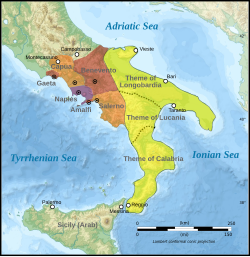Longobardia
| Theme of Longobardia Λογγοβαρδία, θέμα Λογγοβαρδίας |
|||||
| Theme of the Byzantine Empire | |||||
|
|||||
| Map of Byzantine themes in Italy (yellow) c. 1000. | |||||
| Capital | Bari | ||||
| Historical era | Middle Ages | ||||
| • | Byzantine conquest of Bari | 876 | |||
| • | Establishment as a theme | ca. 891 | |||
| • | Establishment of the Catepanate of Italy | 965 | |||
| Today part of |
|
||||
Longobardia (Greek: Λογγοβαρδία, also variously Λογγιβαρδία, Longibardia and Λαγουβαρδία, Lagoubardia, was a Byzantine term for the territories controlled by the Lombards in Italy. In the 9th-10th centuries, it was also the name of a Byzantine military-civilian province (or thema) known as the Theme of Longobardia located in southeastern Italy.
The term was traditionally used for the Lombard possessions, with the chronicler Theophanes the Confessor distinguishing between "Great Longobardia" (Greek: Μεγάλη Λογγοβαρδία; Latin: Longobardia major), namely the Lombard kingdom in northern Italy, and "Lesser Longobardia" (Latin: Longobardia minor), which comprised southern Italy, with the Lombard duchies of Spoleto, Salerno and Capua, the Byzantine possessions, and the city-states (Naples, Gaeta and Amalfi) under Byzantine suzerainty.
In its strictest and most technical sense, the name referred to the province (thema) which encompassed the modern Italian region of Apulia and parts of Basilicata, with Bari as its capital. Its exact origin and evolution are not entirely clear. After a century of almost complete absence from the affairs of the Italian peninsula, Byzantium once more began to intervene actively under Basil I the Macedonian (reigned 867–886), whose western policy aimed to clear the Adriatic Sea from Saracen raiders, re-establish Byzantine dominance over Dalmatia, and extend Byzantine control once more over parts of Italy. In this process, Otranto was taken from the Saracens in 873, and in 876 the Byzantines took over Bari, which had been captured from its Saracen rulers in 871 by Louis II of Italy. It was probably at this juncture that the foundations of the later theme were laid, perhaps in the form of a subordinate division (tourma) of the thema of Cephallenia.
...
Wikipedia

